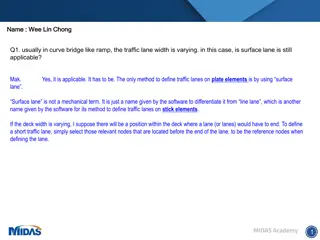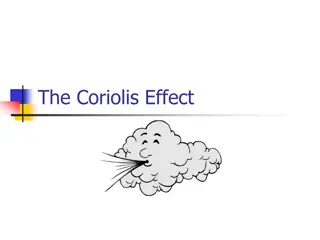Understanding the Interpretation of Model Summary Numbers in Pupil Dilation Growth Curve Analysis
When analyzing a growth curve model for pupil dilation, the model summary provides various numbers such as Intercepts, Poly1, Poly2, Condition effects, and interaction terms. Understanding these numbers is crucial for interpreting how pupil dilation is predicted by time and affected by experimental conditions.
Download Presentation

Please find below an Image/Link to download the presentation.
The content on the website is provided AS IS for your information and personal use only. It may not be sold, licensed, or shared on other websites without obtaining consent from the author. Download presentation by click this link. If you encounter any issues during the download, it is possible that the publisher has removed the file from their server.
E N D
Presentation Transcript
Growth curve analysis What do those numbers mean? Matt Winn (this presentation works best when you view it as a presentation, and not just the slides in editor view)
Here are some nice data This is the area of growth Hardest condition Easiest condition Don t worry about the details
Here are some nice data With a growth curve model added
Pupil dilation ~ poly(Time, 2) * Condition Pupil dilation is predicted by time; it changes linearly and quadratically, and those changes are affected by the experiment condition
Pupil dilation ~ poly1 + poly2 + Condition + poly1:Condition + poly2:Condition Pupil dilation is predicted by time; it changes linearly and quadratically, and those changes are affected by the experiment condition This is simply another way of writing that formula, where we can explicitly keep track of the terms
Pupil dilation ~ poly1 + poly2 + poly1:Condition + poly1:Condition Term Estimate The model summary gives us all these numbers . How do we interpret them? (Intercept) 0.096 poly1 0.436 poly2 -0.058 Condition32 0.032 Condition16 0.046 Condition8 0.103 Condition4 0.163 poly1:Condition32 0.088 poly1:Condition16 0.182 poly1:Condition8 0.471 poly1:Condition4 0.660 poly2:Condition32 -0.027 poly2:Condition16 -0.030 poly2:Condition8 -0.058 poly2:Condition4 -0.150
Term Estimate Default condition (unprocessed) There are (Intercept) 0.096 poly1 0.436 Intercept effects poly2 -0.058 Condition32 0.032 Condition16 0.046 Condition8 0.103 To get the coefficient for each non-default condition, Condition4 0.163 poly1:Condition32 0.088 poly1:Condition16 0.182 Simply add that condition s Estimate to the Estimate of the default poly1:Condition8 0.471 poly1:Condition4 0.660 poly2:Condition32 -0.027 poly2:Condition16 -0.030 poly2:Condition8 -0.058 poly2:Condition4 -0.150
Term Estimate and (Intercept) 0.096 Default condition (unprocessed) poly1 0.436 Slope effects poly2 -0.058 Condition32 0.032 Condition16 0.046 Condition8 0.103 Condition4 0.163 poly1:Condition32 0.088 poly1:Condition16 0.182 poly1:Condition8 0.471 poly1:Condition4 0.660 poly2:Condition32 -0.027 poly2:Condition16 -0.030 poly2:Condition8 -0.058 poly2:Condition4 -0.150
Term Estimate and (Intercept) 0.096 poly1 0.436 Inflection effects Default condition (unprocessed) poly2 -0.058 Condition32 0.032 Condition16 0.046 Condition8 0.103 Condition4 0.163 poly1:Condition32 0.088 poly1:Condition16 0.182 poly1:Condition8 0.471 poly1:Condition4 0.660 poly2:Condition32 -0.027 poly2:Condition16 -0.030 poly2:Condition8 -0.058 poly2:Condition4 -0.150
Term Estimate These are the coefficients obtained when we do the default+interaction additions Default condition effects (unprocessed) (Intercept) 0.096 poly1 0.436 poly2 -0.058 Condition32 0.032 Intercept effects Condition16 0.046 Condition Intercept Linear Quadratic Condition8 0.103 Unproc 0.096 0.436 -0.058 Condition4 0.163 32 Chan 0.128 0.525 -0.084 poly1:Condition32 0.088 Slope effects 16 Chan 0.142 0.618 -0.088 poly1:Condition16 0.182 poly1:Condition8 0.471 8 Chan 0.199 0.907 -0.116 poly1:Condition4 0.660 4 Chan 0.259 1.096 -0.208 Inflection effects poly2:Condition32 -0.027 poly2:Condition16 -0.030 poly2:Condition8 -0.058 Now we want to understand what these numbers mean. poly2:Condition4 -0.150
Back to the data/model Those numbers we just saw represent the intercept, slope, and inflection of these curves Let s start by looking at one curve at a time.
Now lets take a look at the individual components Components: Slope Inflection
Linear component (slope) Components: Slope Inflection
Quadratic component (inflection) Components: Slope Inflection
Normally when we think about x and x2 Does the curve rise because of the linear part? Or because of the curved part? Raw polynomial terms are correlated data: x and x2 cor = 0.967 r2 = 0.94 y = x Correlated effects are difficult to disentangle
Orthogonal polynomial terms are used to obtain separate effects of slope and inflection Positive linear coefficient increased slope
Orthogonal polynomial terms are used to obtain separate effects of slope and inflection Positive linear coefficient increased slope Negative quadratic coefficient inverted-U shape e e
And theres an overall shift up (the intercept) e
Now that we have these components, let s see how they contribute to the whole. e
(vector) Now it s just linear addition! ^ That was just for one condition. Now that we understand the components, We can look at all of the conditions in the same way.
With this view, it s easy to compare different polynomial terms
But its difficult to visually compare across conditions.
But its difficult to visually compare across conditions. Because we re being asked to compare vertically
When we really want to see it this way Like this
Isnt that easier?
The intercepts get higher The slopes get steeper The inflections get curvier curvier
THATs What those numbers mean.
It might be easier to compare them if they are overlapping.
It might be easier to compare them if they are overlapping. Like this.
Or, if youre horizontally inclined Notice how we can now compare slopes without being distracted by differences in overall height
Now weve learned the connection between THIS and THIS Term Estimate (Intercept) 0.096 poly1 0.436 poly2 -0.058 Condition32 0.032 Condition16 0.046 Condition8 0.103 Condition4 0.163 poly1:Condition32 0.088 poly1:Condition16 0.182 poly1:Condition8 0.471 poly1:Condition4 0.660 poly2:Condition32 -0.027 poly2:Condition16 -0.030 poly2:Condition8 -0.058 poly2:Condition4 -0.150























